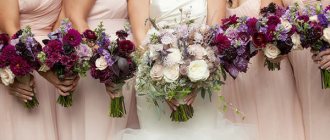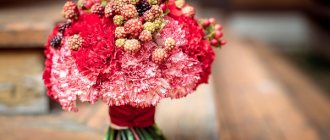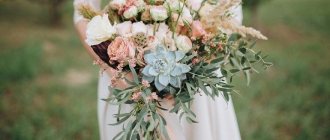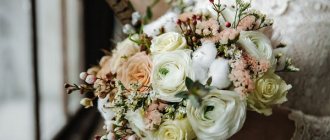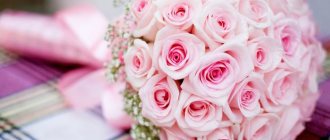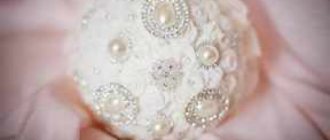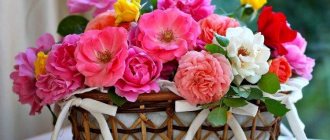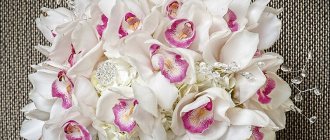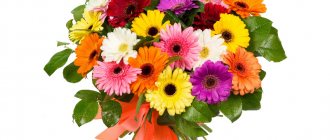The task of preserving the appearance of the bride's bouquet in winter becomes much more difficult due to frost. Therefore, the way winter bridal bouquets look is largely determined by the frost-resistant plants and materials that are used to make them. In addition, the appearance of these bouquets is greatly influenced by the Christmas theme and seasonal decor.
The ideas described in this post are highlighted conditionally. Often in real bouquets several of them are used at once - and this can be seen in the photographs. The division is needed only to draw attention and place emphasis.
From the Christmas theme, cones, pine needles in red and burgundy tones, cinnamon, brooches, and Christmas tree decorations came to the winter bouquets of brides. All this looks great in winter, retains its appearance for a long time and creates the mood of a holiday and a fairy tale. Can you just imagine how bouquets made with cinnamon smell?
From the winter story, bouquets include knitted flowers, silver and gold elements (at what other time of year do they look so appropriate?), cold blue and purple shades, muff bouquets that warm the bride’s hands, cotton reminiscent of snow, berries that we so often seen in the trees in winter.
In addition, bouquets of pastel colors with or without dark spots look beautiful in winter. Despite the fact that there is an opinion that such a bouquet will get lost on a white snowy background, many brides still choose pastel flowers, creating contrast in their image through other details - for example, a dark coat or a bright scarf.
Due to their frost resistance and beauty, calla lilies of different colors are often included in winter bridal bouquets; for the same reason, succulents and a lot of greenery are often added to them.
Apples and pomegranates come into winter bouquets from autumn weddings and look no less impressive in them. And for those brides who want to see summer or spring flowers in their winter bouquet, options made entirely or partially from polymer clay may be suitable. They are almost indistinguishable from real flowers.
Red and burgundy notes
Basis for the bouquet
Roses
These flowers are the most common for making a bouquet all year round. And this comes with a lot of advantages:
- roses have a huge palette of shades from pale light to bright and rich;
- they come in a wide variety of shapes and sizes ;
- are divided into different varieties - these are peony, bush, and miniature;
- harmonize well with many other flowers, for example, chrysanthemums, gerberas, carnations, eustomas, freesias, orchids, daisies, peonies;
- resistant to both frost and heat;
- They will look great with any bridal outfit.
For celebrations in the cold season, it is better to use brighter roses - red, burgundy or orange, as they are the most frost-resistant.
Gerberas
Such flowers have long been loved by many girls for their bright and varied colors. They look very cute and interesting, and will also tolerate frost without wilting. They look great both in combination with roses and as a stand-alone bouquet using only them.
Carnations
These plants began to be used for wedding compositions relatively recently, but they have already managed to attract the attention of brides. Carnations can easily withstand cold sub-zero temperatures and retain their beautiful, original appearance. Pairs well with roses, gerberas and chrysanthemums.
Each girl will be able to choose the right shade for herself, because they can be:
- red;
- pink;
- white;
- burgundy;
- purple;
- lilac;
- or lavender.
By the way, carnations symbolize love, purity and fidelity.
Chrysanthemums
Another great option that will not be afraid of frosty weather is chrysanthemums. These cute plants can be used to create a very interesting composition for a wedding, and they will be complemented well with roses, carnations or gerberas.
Calla lilies
These plants are not afraid of either cold or heat, so they are popular all year round. Callas look very unusual and original; a bouquet of them will add mystery and chic to the image. They harmonize wonderfully in compositions with roses and orchids.
Anemones
These flowers amaze with the variety of their shades, they can be:
- red;
- pink;
- blue;
- blue;
- white;
- purple.
Their distinctive feature is the dark center, which attracts attention. An excellent addition to anemones would be ranunculus and roses.
Amaryllis
Large buds look very elegant in a wedding composition and do not require any additional flowers in the bouquet. Meet:
- bright red;
- scarlet;
- orange;
- peach;
- or white.
Often cascading bouquets are made from such plants.
Ranunculus
Another good option that will perfectly fit into the image of a bride in the winter season, as it is not afraid of the cold. Their palette is varied, they are:
- white;
- purple;
- yellow;
- pink;
- creamy.
Ranunculus look very gentle and romantic, so they are perfect for a wedding celebration. For a more interesting composition, add anemones or roses.
The flowers in question resemble peonies, so do not confuse them with them.
Cinnamon
Replacement flowers
Another fashionable trend is to completely abandon living plants in the winter season and replace them with artificial materials.
Bouquets brooches
These options are made of shiny stones or satin ribbons and look very bright, impressive and beautiful. If you don’t want to walk around with such a bouquet all day, then you can only use it during a photo shoot on the street, and take flowers to the banquet.
Christmas decorations
These details are often used by modern brides on their wedding day. They look bright, unusual and shimmer perfectly in the winter sun. Just like the previous option, you can use it only during a walk, and then replace it with a bouquet of living plants.
From the cones
Another practical variety, suitable for frosty weather. It is appropriate to complement the cones with pine or spruce branches and cotton.
Silver and gold elements
Color spectrum
Bouquets in winter style are usually made in two versions.
Or in bright colors:
- red;
- purple;
- yellow;
- blue;
- green;
- fuchsia colors.
Or, on the contrary, in soft pastels:
- pink;
- blue;
- peach;
- cream;
- lilac;
- or silver.
It is worth remembering that if your composition is in rich, flashy shades, then add to it some other elements of the same colors, for example, a belt on a girl’s outfit, shoes, manicure.
If your choice is “calm” bouquets, then choose brighter clothes so as not to merge with nature and not get lost against its background, for example, a coat or cardigan.
Cotton
Form
The choice of the shape of the wedding bouquet is limited only by the imagination of the bride and the florist. You can choose compositions of both classical form and more extravagant ones. The most common forms are the following:
Round is a very popular form of bouquet arrangement, and bouquets can have different structures and heights.
Glamelia. A complex composition consisting of an ensemble of different flowers (petals, buds), which in combination create the image of one large flower.
Ball bouquet - this shape is formed by a spherical base on which the composition is attached. This bouquet can be held by a ribbon in your hand or hung on your wrist. A sponge soaked in water and minerals is placed inside the base, which allows the plants to keep their shape longer.
The cascading bouquet looks like a floral waterfall. To create it, flowers with long stems are selected. With its unusual shape, such an accessory can subtly emphasize the bride’s refined taste.
The bouquet-clutch and the bouquet-handbag are of an applied nature. The first will be especially in demand at low temperatures, since it combines a warm muff and a bouquet composition. A bright bouquet looks impressive against the background of a white muff. The second is a composition reminiscent of a handbag.
Berries
Accessories
Various accessories will help complement the wedding bouquet and make it more vibrant and unique.
You can add originality with the help of plants, for example:
- small and unpretentious waxflower flowers;
- cotton, which creates a feeling of warmth and comfort (ideal for a winter bouquet as it is not affected by temperature);
- Brunia: despite its southern origin, it tolerates cold well. The shape resembles small balls, which allows them to create an airy and unique silhouette of the bouquet;
- large bright hypericum berries (the red color gives the bouquet a unique note of extravagance).
Ribbons are an important design element. Their color, texture, width can emphasize the advantages of the bouquet.
An interesting solution would be to use a lace design reminiscent of frosty patterns on the windows.
For winter arrangements, it is allowed to use a woolen thread wrapped around the base of the bouquet. This design goes well with cotton.
You can add elements of a winter theme to the bouquet, incl. and New Year's:
- branches of coniferous trees;
- rowan branches with berries;
- cones;
- Christmas decorations;
- decorative snowflakes.
Pastel shades and dark accents
Combination with style
A winter wedding bouquet should be in harmony not only with the image of the bride, but also with the theme of the wedding as a whole. Any harmonious combinations are suitable for a classic winter wedding, but stylized weddings require additional elements.
FOR THE BRIDE: MINT BOUQUET FOR A WINTER WEDDING
A flower arrangement can be complemented with themed decorations - this will make it suitable for any decor. For example, for a vintage wedding, antique-style decorations are suitable; for a steampunk theme, gears, chains, springs and other mechanical parts are suitable. Retro style involves the use of large brooches, feathers and lace, while Russian folk style involves the use of cones, fir branches, and dryers.
Apples and pomegranates
How to make it yourself
To do this you will need the following materials and tools:
- penoplex;
- any sweets;
- corrugated paper;
- figurine of newlyweds, beads, ribbons, fabrics, artificial or fresh flowers, etc. For decoration;
- double sided tape;
- sandpaper;
- scissors.
The base for the “cake” is cut out of penoplex. Most often it is made three-tiered, so you will need 3 pieces of different sizes, for example, with a radius of 12, 17 and 25 cm. Each part is sanded with sandpaper to make the edges as smooth as possible. Then the tiers are covered with corrugated paper of the same shade.
After this, it’s time to place the sweets on the dessert. To do this, you can immediately glue them to the base with double-sided tape or first attach them to a strip of paper, and only then to the treat. Horizontal surfaces can also be decorated with candies, placing them in an abstract or ordered composition.
The next step is to decorate the finished dessert. For this, fresh or artificial flowers are used, and if desired, buds can be made yourself from corrugated paper. In addition to this, fabrics, beads, ribbons, sequins and inedible figures are used - newlyweds, doves, swans, etc.
Lots of greenery, succulents, gypsophila
Current colors for winter 2022
For the winter version of the celebration, plain snow-white bouquets are not suitable. Even a royal rose, studded with rhinestones in the form of dew drops, will lose its chic against the backdrop of snow-covered decorations and a lace dress. Florists advise diluting the most noble color with variegated strokes, some rough, some soft. For decoration, greenery or any flowers in crimson, violet, blue or purple colors are suitable.
Winter bridal bouquet photo
Don't be afraid of a warm palette, like yellow sunflower, orange peony, burgundy roses or blue cornflowers. Winter is the time for orchids in any form. It is worth paying attention to the varieties Mokara and Phalaenopsis. You can also complement the bouquet with the help of anemone, ranunculus, calla lilies, hydrangea, and succulents.
Bride's image
A winter bride should look bright and irresistible, since the uncharacteristic time of year for weddings requires uniqueness in every detail. The shade of the bouquet is matched to the dress: if it is white, then it is advisable to use bright buds, and monochrome or contrasting plants will suit a colored outfit.
The hairstyle can be anything depending on the style of the outfit. Ball-type dresses are suitable for voluminous styles, and models with a straight or tight cut are suitable for strict and elegant styles. At a winter wedding, a veil will look harmonious, and if desired, it can be replaced with a tiara or hairpin that matches the color of the bouquet.
In makeup, you can focus either on the eyes or on the lips. In the first case, the Smokey eyes style is suitable for this, and in the second, matte lipstick in a bright shade that harmonizes with the flowers in the bouquet. The manicure can be pastel or rich; if desired, you can make winter patterns on your nails.


